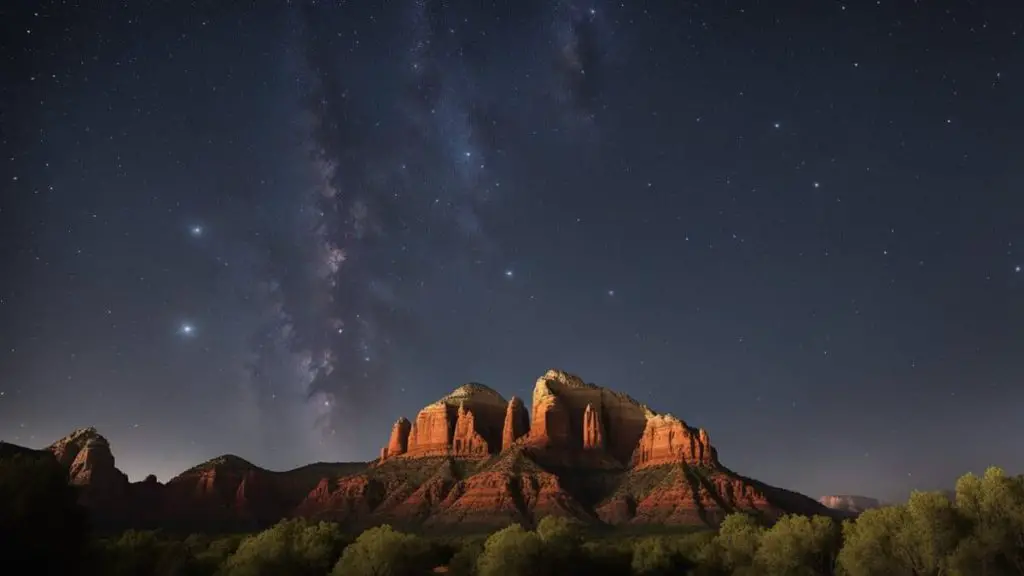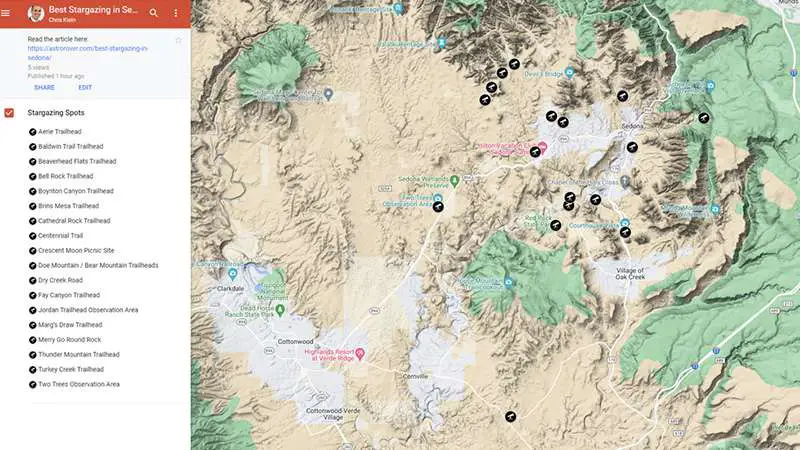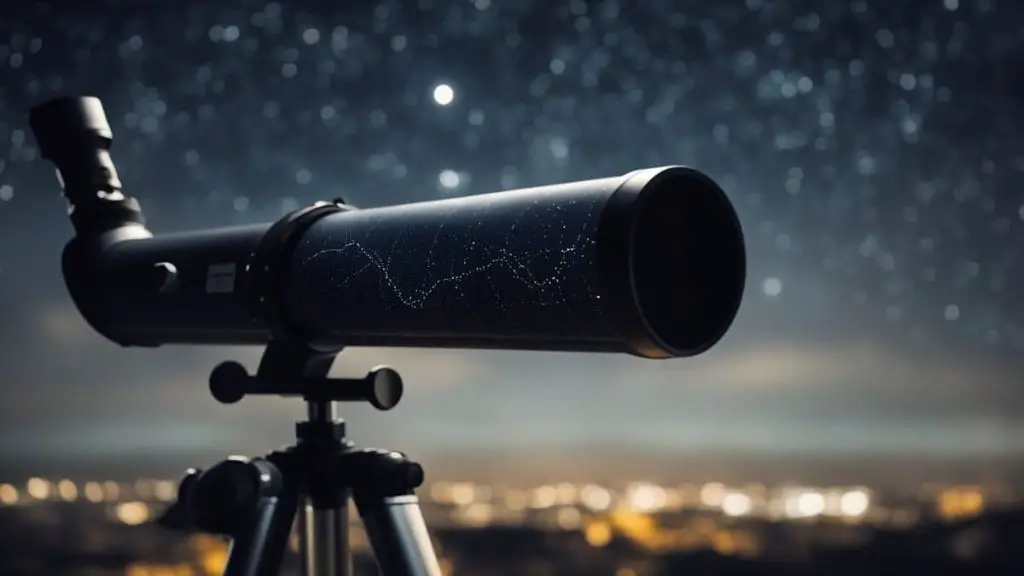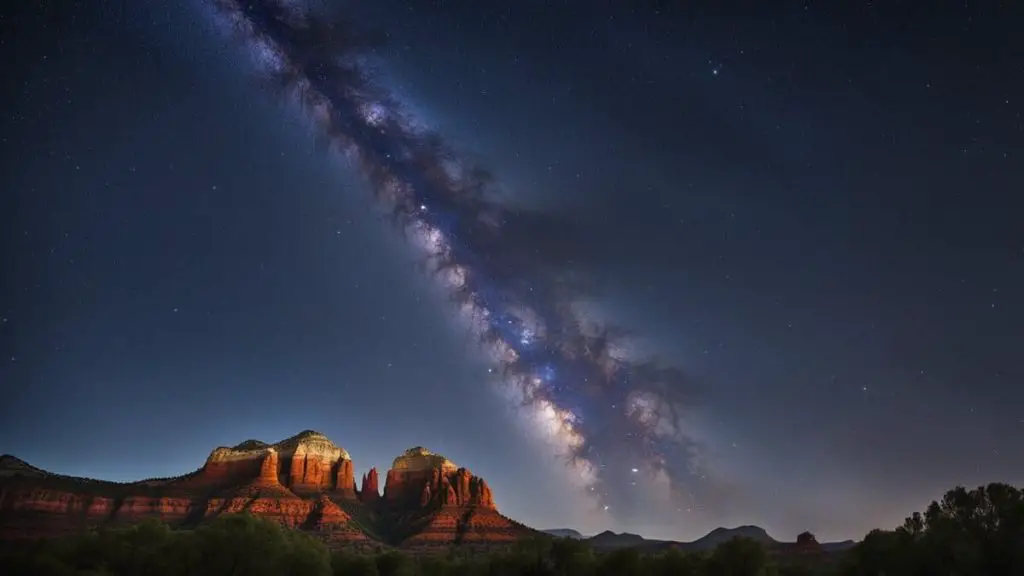You’re eager to explore the night sky in Sedona, drawn by its famed clear, dark skies. The Sedona Bortle Scale offers a gateway to celestial wonders, promising a stellar stargazing experience.
However, navigating the complexities of light pollution and finding the optimal viewing spots can be daunting. Light domes from nearby cities and the technicalities of the Bortle Scale can obscure your view and dampen your enthusiasm.
In this article, I’ll guide you through the Sedona Bortle Scale, showing you how to use it to enhance your stargazing adventures. You’ll learn how to identify the best locations for clear, breathtaking night sky views, overcome the challenge of light pollution, and discover the celestial wonders visible in Sedona’s dark skies.
Key Things to Know:
- The Sedona Bortle Scale helps gauge night sky darkness, enhancing stargazing.
- Light pollution impacts visibility; Sedona’s skies range from Class 2 to 3.
- Ideal spots in Sedona offer clear views of galaxies, nebulae, and constellations.
- Joining local astronomy clubs can enrich your stargazing experience.
Recommended For You
Understanding the Sedona Bortle Scale

The Bortle Scale has been my go-to guide for understanding the night’s darkness and uncovering celestial wonders.
Origins of the Bortle Scale
John E. Bortle introduced the Bortle Scale in 2001 to help amateur astronomers gauge light pollution in the night sky. Based on the sky’s darkness, it ranks how well you can see celestial objects, from stars to galaxies.
Scale Descriptions and Classes

- Class 1: This is the darkest sky possible. It’s a dark sky where you can clearly see the Milky Way.
- Class 9: This is a brightly lit city sky where you might only see the moon and a few stars.
In Sedona, I’ve typically encountered skies ranging from Class 2 to Class 3, which is ideal for my stargazing sessions.
FREE STARGAZING CHECKLIST
My 5-page Stargazing Checklist will enhance your astronomical observations.
Follow this free checklist to navigate the night sky with confidence, clarity, and a sense of preparedness for a rewarding stargazing experience.

Applications in Astronomy
If you’re part of an astronomy club or love looking up, the Bortle Scale tells you how good the stargazing will be. A lower class means more to see!
- I use this scale to plan all my Sedona stargazing trips
- Teach others about light pollution
Even as an amateur astronomer, this scale helps find the best spots around Sedona to set up your telescope.
Visibility Factors in Astronomy

When you look at the night sky in Sedona, you might wonder what impacts your ability to see stars clearly. Here’s what you need to know.
Impact of Light Pollution
From my experience, light pollution significantly affects stargazing quality. It’s like a bright blanket that hides the stars from your view. In Sedona, light domes from nearby cities can make it tougher to spot faint stars with your naked eye or even with binoculars. In my nights observing the sky, I’ve found that less light pollution means a sky brimming with stars.
- Light Domes: Bright halos over cities, ruining the dark skies.
- Visibility: Impacted negatively as light pollution increases.
Measuring Sky Brightness
Astronomers use the Bortle Scale to tell how bright the sky is. You can measure this with a Sky Quality Meter (SQM). I’ve learned that for the best stargazing experiences, aiming for a lower number on the Bortle scale is vital. This means the sky is darker and better for spotting stars.
- Bortle Scale: Ranges from 1 (excellent dark-sky site) to 9 (city sky).
- SQM: A device that measures sky brightness in magnitudes per square arcsecond.
Ideal Observing Conditions
For the best stargazing experience, you want dark skies and a high naked-eye limiting magnitude (NELM). This means you can see fainter stars. Sedona’s at a good Bortle scale ranking, making it an excellent spot for telescopes or binoculars to gaze at stars.
- Look for spots with higher NELM values.
- Dark Skies: Essential for seeing more and fainter stars.
Stargazing in Sedona

Having spent countless nights under Sedona’s clear skies, I can attest to their spectacular star views. It’s one of the best places to look up at night.
Get a free Google Map of the best stargazing in Sedona.

Sedona’s Dark Sky Community
Sedona has worked hard to minimize light pollution. This makes the night sky clearer for you. The International Dark-Sky Association recognizes Sedona as a Dark Sky Community. Here’s what that means for you:
- Clearer views of stars and planets with your own eyes.
- Better chances to see the Milky Way on a dark, moonless night.
Prime Observing Sites
In Sedona, you’ll find many spots perfect for setting up a telescope or gazing at the stars.
Here are some top places to check out:
- Two Trees Observing Area: For minimal light pollution and optimal stargazing conditions.
- The Jordan Trailhead Observing Area
- National Parks in the area: Many offer dark skies away from city lights.
Use a light pollution map to find the darkest skies. Remember, the darker the place on the map, the better you’ll see the stars.
When you pick a spot, look for the following:
- Easy access so you can bring your gear.
- Low light pollution for the best view of the night sky.
Astronomical Objects by the Bortle Scale

When stargazing in Sedona, the Bortle Scale can guide you on what celestial wonders you might see. Different scale ratings affect the visibility of objects like stars and planets.
Identifying Celestial Objects
You’ll see more in Sedona with a darker night sky than in a city.
Here are some sights you can expect:
- Constellations: Clear patterns of stars are more visible.
- Milky Way: This galaxy can become visible on moonless nights.
- M33 and M31: These are the Triangulum and Andromeda galaxies and are quite a sight under darker skies.
Deep-Sky Viewing
Your deep-sky stargazing in Sedona is thrilling because:
- Nebulae and galaxies: These faint objects stand out with little light pollution.
- Messier objects: You can tick many off your list, like the famous Orion Nebula (M42).
- Globular clusters: These tight groups of stars become distinguishable.
Observing Solar System Wonders
Even some objects in our solar system benefit from a dark sky:
- Planets: Jupiter and Venus shine bright and are easy to spot.
- Zodiacal light: Looks like a faint column of light extending from the horizon.
- Airglow: A subtle, diffuse glow of Earth’s atmosphere, it’s a treat on a very dark night.
Advancing Amateur Astronomy

Amateur astronomy can be far more enriching when you connect with the right people and use the best tools. With their low light pollution, Sedona’s skies provide a perfect canvas for stargazers and photographers alike.
Joining Astronomy Clubs
Engaging with an astronomy club in your area can boost your knowledge and skills.
Here’s why:
- Clubs often host events where you can learn and share experiences.
- They offer access to research tools and telescopes that might be too costly to purchase on your own.
Photography and the Night Sky
Capturing the wonders of the night sky requires some specific gear:
- A camera capable of taking long-exposure shots.
- A tripod to keep your camera steady.
In a place like Sedona, the sky’s brightness makes astrophotography a dream.
Astronomy Tools and Resources
To navigate the stars more easily, you’ll need some essential tools:
- Use a red-light flashlight to see in the dark without hindering your night vision.
- A good star chart or an app like Stellarium can help identify celestial bodies.
Protecting Dark Skies
Dark sky places, like some national parks, offer pristine stargazing conditions. By protecting these sites, you ensure future astronomers can enjoy the stars.
Here’s how you can help:
- Use lights at home that minimize glare.
- Support dark sky preservation efforts.
Touring Arizona’s Night Skies

Exploring the starry night skies of Arizona offers a magical experience. With renowned dark-sky sites, you can witness the beauty of the cosmos.
Here’s your guide to unforgettable celestial tours in the state.
National Park Night Tours
Arizona’s national parks are not just about daytime adventures. By night, places like Grand Canyon National Park and Petrified Forest National Park transform into spectacular dark-sky sites.
- Grand Canyon: It’s not just the breathtaking views from the rim. Look up to see a blanket of stars.
- Petrified Forest: Step into a prehistoric landscape by day, but come nightfall, it’s all about those stellar views.
You might even find ranger-led night tours to give you insights into the night sky.
Sedona’s Stargazing Experiences
In Sedona, the night sky takes center stage thanks to the city’s commitment to preserving its dark skies.
- An observatory lets you get a closer look at planets and stars.
- You can also visit designated dark-sky sites expressly set up for an optimal viewing experience.
Tip: Join a local astronomy club event in Sedona for expert stargazing guidance.
Events and Star Parties
Arizona loves to celebrate its stellar nights with communal events:
- Star parties: Usually held at parks like Kartchner Caverns State Park and Saguaro National Park. These gatherings bring together professional and amateur astronomers.
- Astronomy club meetings often become impromptu star parties, creating a fun learning environment.
Attending these events has been perfect for deepening my knowledge of the night sky and connecting with fellow enthusiasts.
Keep an eye on local calendars for upcoming gatherings.
By participating in these experiences, you can embrace the beauty of Arizona’s skies. Whether you’re peering into the depths of the universe from an observatory or lying on a blanket at a national park, Arizona’s night tours are indeed a sight to behold.
Frequently Asked Questions
How can I determine the Bortle Class of a specific location not mentioned in the article?
To determine the Bortle Class of a location, you can use a Sky Quality Meter (SQM) to measure the night sky brightness. Many astronomy apps and websites also offer maps that estimate the Bortle Class based on light pollution data.
What’s the best time of year to stargaze in Sedona?
The best time of year to stargaze in Sedona is during the dry months, from May through September, when the skies are clearer, and the visibility of celestial objects is enhanced due to minimal atmospheric disturbance.
Can I contribute to reducing light pollution in my area?
Yes, you can contribute to reducing light pollution by using outdoor lighting that is fully shielded, pointing downwards, and limiting the use of bright, white lights. Advocating for community-wide dark sky policies also helps preserve the night sky for everyone.
TL;DR
- The Sedona Bortle Scale is essential for evaluating night sky darkness and planning stargazing activities.
- Light pollution affects visibility, but Sedona’s efforts have maintained its skies at Class 2 to 3, ideal for astronomy.
- Key spots in Sedona offer minimal light pollution for viewing galaxies, nebulae, and constellations.
- Joining local astronomy clubs in Sedona can enhance your knowledge and stargazing experience.
- Tools like the Sky Quality Meter and apps can help you find the best locations for observing the night sky.
Your curiosity fuels our shared journey through the cosmos, and your insights enrich our collective understanding. I may not have all the answers, but I’m eager to explore your questions and thoughts.
What sparks your interest, or what would you like to know more about? Please share your questions and comments below; let’s navigate the stars together.




